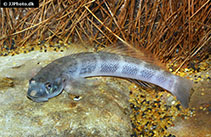| Diagnosis: |
Dorsal spines (total): 7; Dorsal soft rays (total): 10; Anal spines: 1-1; Anal soft rays: 9-10. Diagnosis: posterior tip of upper jaw extends to level of anterior 1/3 or 1/2 of eye; each half (left and right) of upper jaw with 22-36 long, slender, setiform, tricuspid teeth (Ref. 57403, 79590). Upper lip crenate, with an inner longitudinal furrow and a small median tubercle just posterior to the median notch; 2 pores in preopercular canal; 2-3 suborbital pigment bands (Ref. 57403, 79590).
Description: anterior teeth, attached to opposite halves of upper jaws, narrowly separated from each other by small fleshy swelling (Ref. 79590). Lower jaw with 1-6 caniniform teeth; 20-33 labial teeth on each side; in adults, anterior labial teeth, attached to opposite lower jaws, narrowly separated by a small projection of soft tissue at dentary symphysis (Ref. 57403, 79590). Up to 15 cycloid predorsal scales on nape (Ref. 57403, 79590), becoming progressively more subdermal anteriorly (Ref. 57403). 52-66 scales in longitudinal series (including 2 scales on caudal fin base); 14-20 in rearward transverse series (Ref. 57403, 79590). Anterior scales on flanks (at the level of pectoral fin) slightly subdermal, cycloid or weakly ctenoid; scales on posterior part of flanks strongly ctenoid with exception of last 2 rows which are cycloid; ctenoid scales on dorsum extending anteriorly at least to origin of 1st dorsal fin; scales adjacent to dorsal fins and on dorsal part of caudal peduncle cycloid (Ref. 57403). Abdomen naked at ventral midline (Ref. 57403, 79590). Scales adjacent to anal fin and ventral part of caudal peduncle cycloid (Ref. 57403). 18-24 scales around caudal peduncle; 1st dorsal fin: VI; second dorsal fin: I,10; anal fin: I,10 (rarely I,9); pectoral fin: 17-19 (Ref. 57403, 79590). Caudal fin squarish or slightly rounded (Ref. 57403) with 16-18 segmented rays, 11 to 14 of which are branched (Ref. 57403, 79590). Preopercular canal incorporating only 2 pores (Ref. 79590). Urogenital papilla small and rounded (Ref. 57403).
Coloration: preserved specimens: back marbled with brownish-green, belly whitish to yellow; upper lip and antero-dorsal part of snout mottled dark brown; occipital region and nape lighter, but showing some brownish-black patches; sides of head with 2-3 oblique, brownish-black bands; anterior band from eye to upper jaw (this band sometimes absent); middle band from below center of eye towards upper jaw; posterior band over suborbital and opercular region of head, sometimes divided into 2 parts; flanks, from pectoral fin base to end of 1st dorsal fin light brown but with several paired, dark brown spots dorsal to lateral midline; from below 1st dorsal fin to caudal peduncle, 5-6 broad, vertical dark bands, separated by narrower, paler bands; base of caudal fin with a narrow crossbar (Ref. 57403, 79590). Ventral parts of body paler than flanks (Ref. 79590). Dorsal fins with brownish-black spots, 1st dorsal darker than 2nd; anal fin speckled at distal margin; dark brown spot at base of pectoral fin; fin membrane slightly speckled, with 1-2 darker spots near bases of upper rays; caudal fin with narrow, vertical, dark brown band and fin membrane lightly speckled brown; pelvic fins pale yellowish (Ref. 57403, 79590). In life: ventral part of pectoral fin yellowish; anterior membrane of pelvic disc red (Ref. 57403, 79590). |
| Biology: |
Amphidromous freshwater species (Ref. 92840). Inhabits fast flowing parts of rivers that have rocky substrates and usually associated with rainforest zones (Ref. 10702, 57403, 79590). Adults apparently spawn in fresh water but the larvae are carried downstream to the sea, metamorphose and migrate back upstream, this cycle explaining the presence of small specimens in coastal waters (Ref. 79590). Maximum observed standard length 6.63cm (Ref. 10702, 79590). Seems evasive and difficult to catch (Ref. 57403, 79590). |

